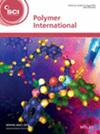求助PDF
{"title":"纳米羟基磷灰石在聚(磺化富马酸丁二钠-共丙烯酸)内作为骨支架的湿化学合成:磺酸基和羧酸基的影响","authors":"Nadia Mahmoudzadeh, Hadi Shirali, Faramarz Afshar Taromi","doi":"10.1002/pi.6738","DOIUrl":null,"url":null,"abstract":"<p>This study investigates the synthesis, nucleation and modification of biodegradable poly(sodium sulfonated butylene fumarate-<i>co</i>-acrylic acid)/hydroxyapatite nanocomposite scaffolds for bone tissue engineering, with a focus on the effects of incorporating hydrophilic sulfonate and carboxylic acid groups. Poly(butylene fumarate) was sulfonated at varying degrees and used to form nanocomposites through <i>in situ</i> nucleation of nanohydroxyapatite (nHA) in a simulated body fluid solution. Critical parameters such as water absorption, swelling behavior, mechanical properties, nanoparticle dispersion and biocompatibility were evaluated. Water uptake ratios ranged from 2.72 to 6.88 g g<sup>−1</sup>, while compressive modulus values increased up to 25.9 times compared with the corresponding homopolymers, demonstrating improved mechanical stability. Despite the formation of over 80% nanoparticles, well-distributed nHA, with sizes averaging 39 ± 13 nm, was achieved through the incorporation of sulfonated groups, preventing nanoparticle agglomeration within the scaffold matrix. Additionally, the scaffolds supported human dermal fibroblast adhesion and proliferation, with cell viability remaining high throughout the culture period. These results suggest that the developed nanocomposite scaffolds offer enhanced biocompatibility, mechanical strength and osteogenic potential, making them promising candidates for bone tissue regeneration applications. © 2024 Society of Chemical Industry.</p>","PeriodicalId":20404,"journal":{"name":"Polymer International","volume":"74 5","pages":"434-443"},"PeriodicalIF":3.6000,"publicationDate":"2024-12-22","publicationTypes":"Journal Article","fieldsOfStudy":null,"isOpenAccess":false,"openAccessPdf":"","citationCount":"0","resultStr":"{\"title\":\"Wet chemical synthesis of nanohydroxyapatite within poly(sodium sulfonated butylene fumarate-co-acrylic acid) as bone scaffold: effects of sulfonate and carboxylic acid groups\",\"authors\":\"Nadia Mahmoudzadeh, Hadi Shirali, Faramarz Afshar Taromi\",\"doi\":\"10.1002/pi.6738\",\"DOIUrl\":null,\"url\":null,\"abstract\":\"<p>This study investigates the synthesis, nucleation and modification of biodegradable poly(sodium sulfonated butylene fumarate-<i>co</i>-acrylic acid)/hydroxyapatite nanocomposite scaffolds for bone tissue engineering, with a focus on the effects of incorporating hydrophilic sulfonate and carboxylic acid groups. Poly(butylene fumarate) was sulfonated at varying degrees and used to form nanocomposites through <i>in situ</i> nucleation of nanohydroxyapatite (nHA) in a simulated body fluid solution. Critical parameters such as water absorption, swelling behavior, mechanical properties, nanoparticle dispersion and biocompatibility were evaluated. Water uptake ratios ranged from 2.72 to 6.88 g g<sup>−1</sup>, while compressive modulus values increased up to 25.9 times compared with the corresponding homopolymers, demonstrating improved mechanical stability. Despite the formation of over 80% nanoparticles, well-distributed nHA, with sizes averaging 39 ± 13 nm, was achieved through the incorporation of sulfonated groups, preventing nanoparticle agglomeration within the scaffold matrix. Additionally, the scaffolds supported human dermal fibroblast adhesion and proliferation, with cell viability remaining high throughout the culture period. These results suggest that the developed nanocomposite scaffolds offer enhanced biocompatibility, mechanical strength and osteogenic potential, making them promising candidates for bone tissue regeneration applications. © 2024 Society of Chemical Industry.</p>\",\"PeriodicalId\":20404,\"journal\":{\"name\":\"Polymer International\",\"volume\":\"74 5\",\"pages\":\"434-443\"},\"PeriodicalIF\":3.6000,\"publicationDate\":\"2024-12-22\",\"publicationTypes\":\"Journal Article\",\"fieldsOfStudy\":null,\"isOpenAccess\":false,\"openAccessPdf\":\"\",\"citationCount\":\"0\",\"resultStr\":null,\"platform\":\"Semanticscholar\",\"paperid\":null,\"PeriodicalName\":\"Polymer International\",\"FirstCategoryId\":\"92\",\"ListUrlMain\":\"https://scijournals.onlinelibrary.wiley.com/doi/10.1002/pi.6738\",\"RegionNum\":4,\"RegionCategory\":\"化学\",\"ArticlePicture\":[],\"TitleCN\":null,\"AbstractTextCN\":null,\"PMCID\":null,\"EPubDate\":\"\",\"PubModel\":\"\",\"JCR\":\"Q2\",\"JCRName\":\"POLYMER SCIENCE\",\"Score\":null,\"Total\":0}","platform":"Semanticscholar","paperid":null,"PeriodicalName":"Polymer International","FirstCategoryId":"92","ListUrlMain":"https://scijournals.onlinelibrary.wiley.com/doi/10.1002/pi.6738","RegionNum":4,"RegionCategory":"化学","ArticlePicture":[],"TitleCN":null,"AbstractTextCN":null,"PMCID":null,"EPubDate":"","PubModel":"","JCR":"Q2","JCRName":"POLYMER SCIENCE","Score":null,"Total":0}
引用次数: 0
引用
批量引用





 求助内容:
求助内容: 应助结果提醒方式:
应助结果提醒方式:


